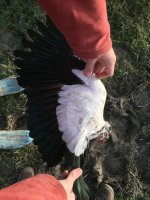Hi guys,
My girlfriend found this wing in her horse's field this morning. I assume a fox has eaten it as they tend to leave the wings, but we have no idea what bird it has come from.
Can anybody identify it?? We live outside of Oxford.
Thank you!
My girlfriend found this wing in her horse's field this morning. I assume a fox has eaten it as they tend to leave the wings, but we have no idea what bird it has come from.
Can anybody identify it?? We live outside of Oxford.
Thank you!







